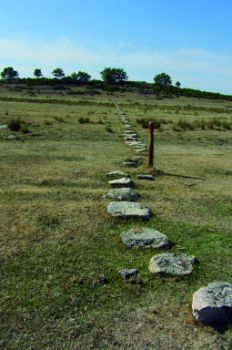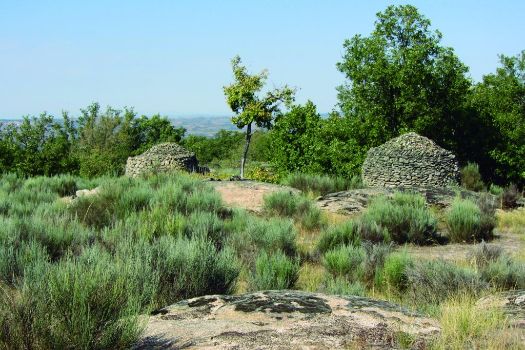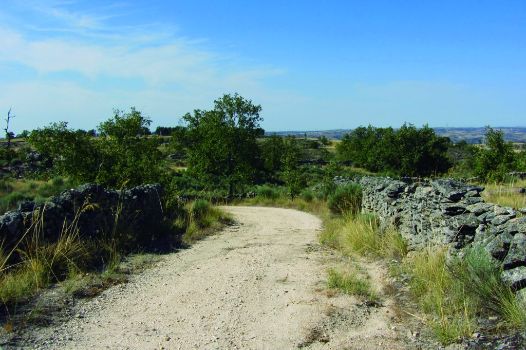Net of Natural
Trails

Stage 33: Trabanca - Villarino de los Aires
Description
On the banks of the Pescadera: The route of the Regatos
The pastures of the Arribes peneplain take centre stage in this Stage. A route in which the landscape is dominated by brooms, a few Pyrenean oaks and vast pastures. Despite the arid nature of the terrain, there is abundant activity. It is not uncommon to see the majestic flight of a Golden Eagle searching for prey.

The route begins at the town of Trabanca (Salamanca), next to the road leading to Cabeza de Framontanos. Further on, the route turns onto a narrower path that emerges on the right, wedged between stone walls that serve as the property lines of private farmsteads.
About 100 metres further on, the path crosses a wooden gate. The route ventures through a sea of Scotch brooms (Cytisus scoparius), and continues to the highest point, known as Los Cotorrones, where a group of Pyrenean oaks (Quercus pyrenaica) have formed an island.
The path reaches an area blanketed with grasses, with fewer and smaller scrubs. This is the bottom of the Matalamula Creek Valley, which coincides with the area known as Rivera de la Pescadera.

The Trail runs along the flood plain to a small pontoon that crosses over a small brook. Behind the pontoon is a row of perfectly aligned, stepping stones that allow the traveller to cross the pasture without getting wet feet when it is waterlogged.
The route gradually climbs up the valley floor. About 2 kilometres into the route, the path traverses through completely flat grassland, with an occasional broom thicket. Shortly after, the route reaches a track, where it turns left, venturing through an area covered with dense Scotch broom thickets, occasionally interrupted by grazing lands or large granite outcrops, until it reaches a crossroads with the so-called Camino del Contumero, where it turns right.
The route proceeds between fenced farmsteads populated with holm oaks (Quercus ilex), Pyrenean oaks, Scotch brooms, thyme (Thymus sp.) and large boulders.

The path rises slowly, and then descends toward a fork, past two bends. It continues along the right path, known as Camino del Pilo or San Roque, past a cattle grid (a grid placed on the ground to prevent the semi-free-ranging cattle from crossing into a different forest).
Further on, the route runs between stone walls that serve as boundaries between privately-owned grasslands. The landscape is dotted with a few farms with olive groves and vineyards, and some shepherd huts or shelters amidst Pyrenean oaks.
The route meanders and changes direction several times during this last stretch, always bound by stone walls. A steep descent leads to the end of the Stage at Villarino de los Aires.
Sites of interest
Profile

Highlights
Información adicional
Casitos
The "casitos" or shepherd huts are stone constructions built without mortar, used by shepherds and drovers as shelter during the day or the night, when bad weather kept them from returning to their home. Sometimes, whole families lived in them.
They were built in mountain areas, especially in densely wooded areas where goats grazed, especially in the past, when they were more abundant.
Life in the grasslands
If there is ever an animal that is perfectly adapted to this habitat of pastures and scotch brooms, it is the rabbit (Oryctolagus cuniculus). Hidden among the brooms (Cytisus sp.), it only takes to the open space to feed on herbaceous plants, an opportunity that Golden Eagles (Aquila chrysaetos) and Bonelli's Eagles (Hieraaetus fasciatus), overflying the open plains, take advantage of to dive down out of the sky to pluck their daily meal.
Cows are also perfectly adapted to this environment, provided they have a watering place. Although the most common breed of cattle in the region is "morucha", the "Sayaguesa" breed, native to this area, can also be frequently found. The Sayago breed was used as a working animal for its hardiness and adaptability to changing conditions; however, the mechanisation of farm work led to their decline, and they are now bred for meat, widely appreciated by consumers.





